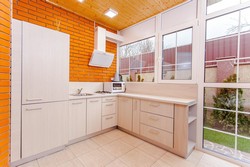Although there are plenty of simple, inexpensive, or nearly free home modifications that can help those with a visual impairment, sometimes you have to spend a little bit of money to make life more manageable. Some people opt to hire professionals that can help simplify their lives – like a contractor who specializes in modifications for those with visual impairments – but there are all kinds of tech tools that can be helpful, too. Here are some useful products for anyone trying to make a house safer and more comfortable for loved ones with vision loss.
Touch or Motion-sensing Lights
Anyone who specializes in dealing with vision loss will tell you that proper lighting is the number one way to make your house more accommodating. Area lights and lamps are necessary in all rooms of the house, but you can’t really stick a lamp in a closet or in a cabinet. That is why it’s important to have supplemental light in any place where one might need it. Having direct light in, let’s say, a medicine cabinet makes sense. Installing rechargeable or battery-powered lights is a good idea. Many of them are lightweight enough that they can be stuck with an adhesive. Even motion-sensing LED lights are pretty inexpensive these days. This motion-sensor, battery-operated light is a great option for inside or underneath cabinets, closet interiors, or even the garage, and is budget-friendly at about $15.
Screen Magnifiers
For someone with vision loss, bigger is usually better. Small screens – on computers, TVs, or e-readers – can be hard to see and can cause eye fatigue and strain. Investing in a screen magnification system could be well worth the money in the long run. There are magnifiers available for larger screens. and even some smaller ones for cell phones and other small personal devices (this option is inexpensive at about $11, and is compatible with any mobile or smartphone).
Voice Clocks/Alarms/Timers
Inexpensive solutions now exist for those who have trouble reading and setting clocks, timers, and alarms. A high-quality device with easy-to-see (usually colorful) setting buttons, large display, and speech technology can make waking up, cooking, and remembering to take medication much easier. This model, which costs about $35, utilizes all of these features for extra convenience.
Handrails and Guide Bars
Sturdy metal or plastic handrails are so cheap now that it’s easy to have as many as you think you need around any areas where stability could be an issue. This includes, but is not limited to, near doorways, around the bathtub and shower, and anywhere in the kitchen. Just think about the places you’re most-likely to need some guidance, maybe due to slick floors or because you’re getting in or out of something. This grab bar swivels and is removable, and costs about $21.
No-slip Floor Mats
Tripping and falling is a big concern for those with visual impairment, as household items that would pose no threat otherwise are now hazardous due to the vision loss. Most people want to keep their rugs, but the fact is that any sort of elevation change or non-smooth transition can be unsafe. To make sure rugs stay in place, rubber mats designed to keep rugs from moving are essential. They’re also inexpensive, which is a huge plus. This padding costs about $30 and has plenty of material to use for multiple rugs.
Liquid Fill Indicator
Even if your low vision prevents you from doing a lot of cooking, you still need to fill glasses, measuring cups, and coffee mugs with liquid – and sometimes that liquid is hot.
A liquid fill indicator (like this one, which runs about $18) can be a real lifesaver. All you do is hang the device on the container you’re using and it will alert you when the liquid level is nearing the top. It’s highly portable and can fit on most any straight-edged container, so it’s a super versatile product that you can even use for cleaning/mopping.
Technology has come around to make living with a visual impairment much more manageable than it was in years past. It’s worth it to take a look at some of the gadgets and devices out there that could be worthwhile investments. But it’s also important to remember that there are still plenty of low-tech solutions that can help you keep your home organized and accessible. Hiring a housekeeper, labeling frequently used items, and de-cluttering living areas are also just a few of the ways you can improve organization, accessibility, and mobility in your home.
Photo Credit: Pexels.com

